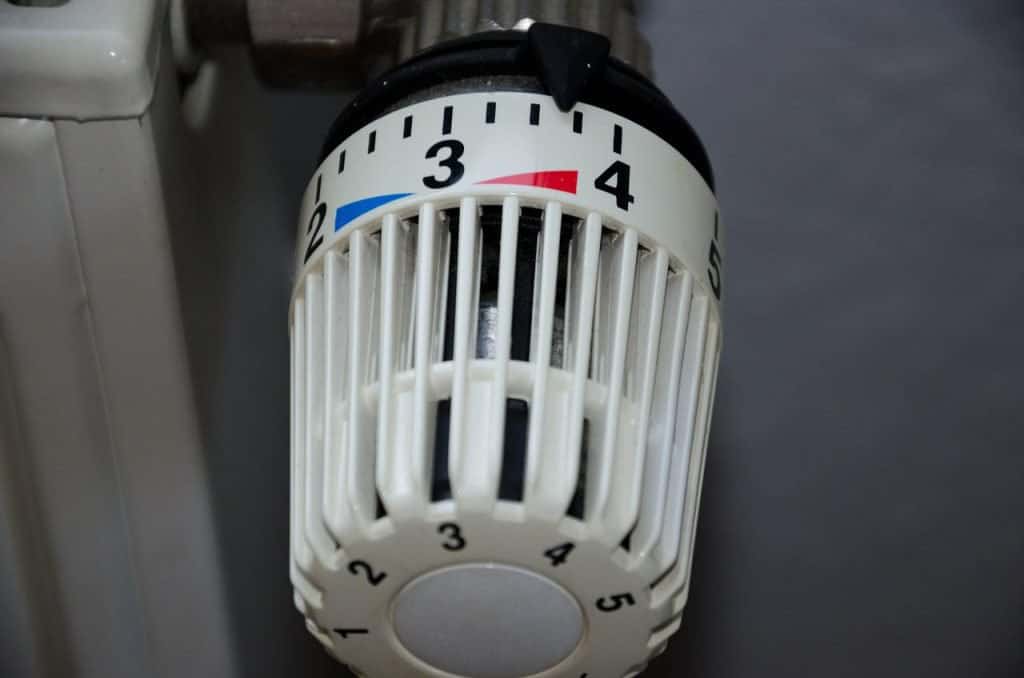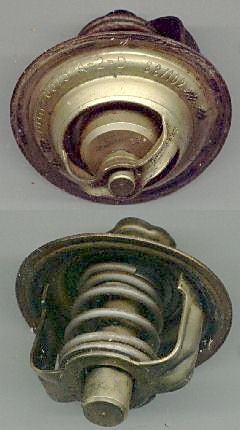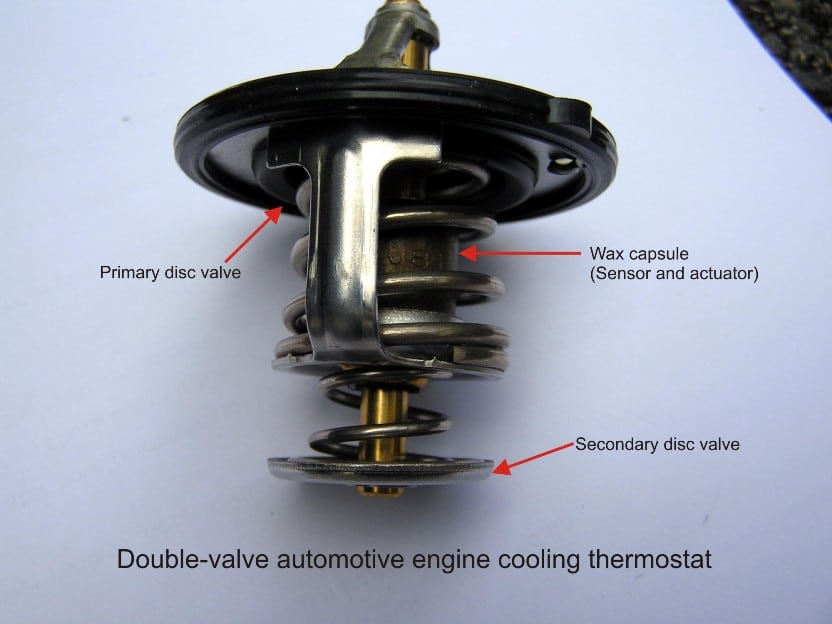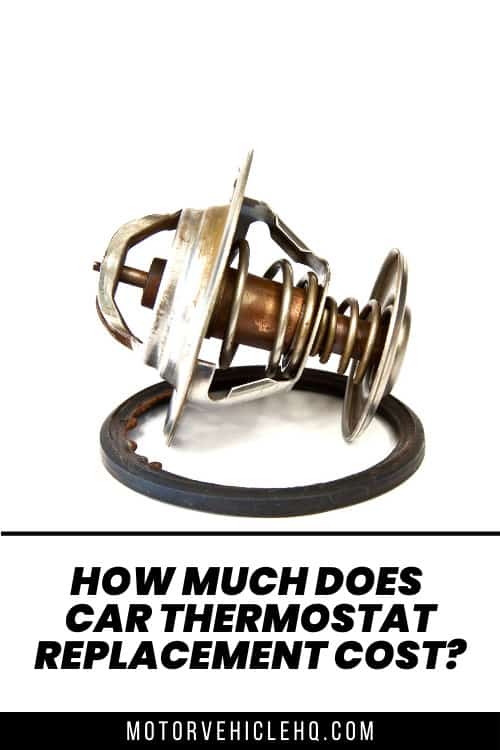In contrast to your home’s thermostat, the thermostat in your automobile does more than merely monitor the temperature. When something goes wrong with your thermostat, you must get it fixed as soon as possible since it is crucial to maintaining the proper temperature in your car. But how much does a car thermostat replacement cost?
Although it is a relatively small part, the thermostat is essential for controlling your engine’s temperature and the operation of your car. If it becomes broken or worn, you should replace it right away to avoid further, more expensive repairs.
The typical car thermostat replacement cost is between $300 and $500. Of course, the make, model, and year of the car you’re driving will also have a significant impact.
What Is a Car Thermostat?
One of the key elements in the cooling system of a car is the thermostat, whose primary job is to control the flow of radiator-based engine cooling to avoid engine overheating.
When the engine cooling system is working, the engine’s internal temperature is maintained at a desirable level. In the water line that connects the engine to the radiator, you’ll find the thermostat.
Because the combustion process in the engine will function optimally at these temperatures, engine power will be at its highest, and fuel consumption will be at its lowest, making these temperatures the ideal range for engine operating temperatures.
The Function of a Car Thermostat
The car thermostat is a valve that is a part of the cooling system. It aids in controlling the flow of coolant from the engine to the radiator and back.
Without a thermostat, your engine would not be able to run at the correct temperature, which would cause catastrophic damage from overheating.
Thermostat Heating radiator heat temperature cold
The thermostat’s valve is operated by a piston in certain types or by a spring that opens and shuts the valve. Thermostats with more modern technology are electrically regulated.
When the thermostat is functioning correctly, coolant travels from the engine to the radiator to ensure a constant temperature. The coolant flow is incorrectly controlled if the valve becomes stuck open or becomes clogged with clothing.
The thermostat is a tiny component that is located between the radiator and the engine. When the engine is at the proper temperature, the valve opens, allowing coolant to flow around the engine and eventually lowering the temperature.
The valve closes after your engine has completely cooled, briefly stopping the flow of coolant and allowing the engine to preheat.
That’s how it functions when your automobile is starting up after a period of inactivity. It permits the engine to warm up before coolant flow is required to maintain a low temperature.
Thanks to a little bit of wax that is within, the thermostat can open and close at the proper times. 180 degrees is the approximate temperature at which the wax melts. Once the wax has melted, it lets go of the rod that is pressing down to open the cylinder.
Wax resolidifies and secures the rod when the temperature drops. It’s clever and easy to use, and it works.
What Leads to a Car Thermostat Failure?
The thermostat doesn’t inherently deteriorate with time, but other variables might eventually lead to issues. Several reasons might be as follows:
- The valve may be prevented from shutting down by accumulating deposits of dirt and debris from the cooling system.
- The thermostat’s central rod, which controls opening and closing, may move out of alignment or become stuck.
- The wax may expand too much in a hot cylinder, leading to leaks or fractures. The valve could not open all the way or at all if the wax is lost.
- The thermostat housing bolts weren’t torqued down tightly enough.
- Possible coolant reservoir tank leak causing low antifreeze levels
Pouring hot water into the cylinder and then testing the temperature of the water when the valve opens are two ways to check your thermostat’s operation.
It might be challenging to execute the procedure precisely. If you have any suspicions about it, simply replacing the thermostat or taking it to your preferred car repair shop is worthwhile.
Symptoms of an Impending Car Thermostat Replacement Cost
There are a few symptoms that you may watch out for to determine whether the thermostat in your automobile is malfunctioning or fully damaged if there is a problem.
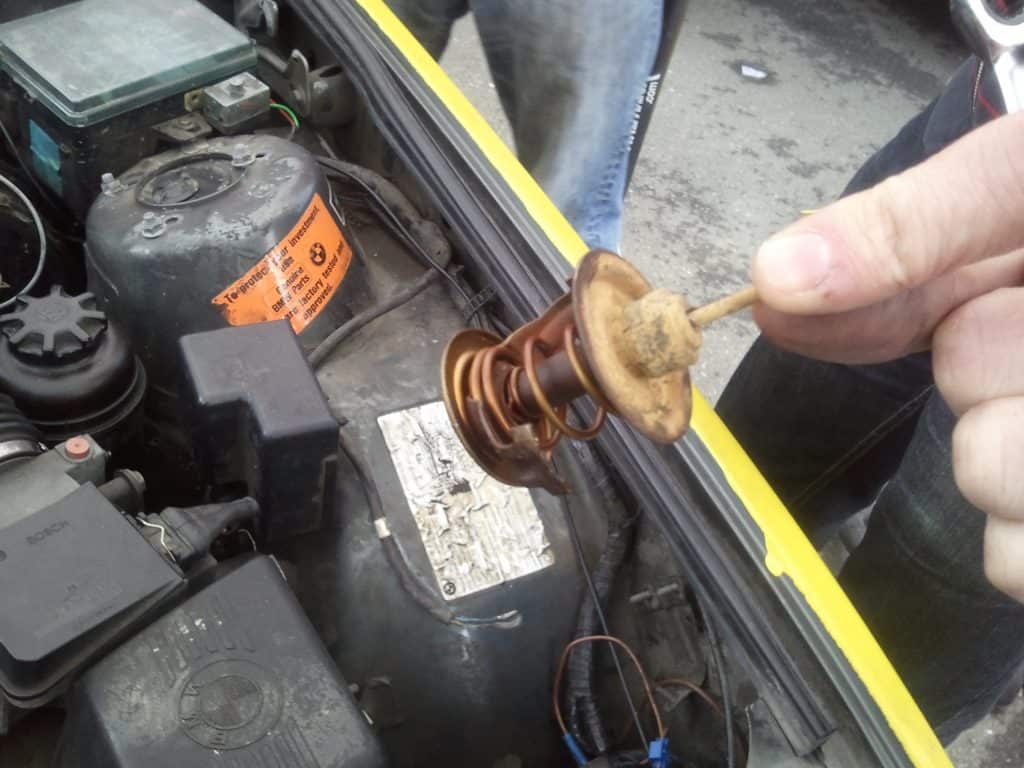
Your thermostat often malfunctions when the valve becomes caught in one of the open or closed positions. Both of these might be hazardous since the coolant flow has to be controlled.
Both having it entirely shut off or having it running constantly run the risk of causing harm to your car. Each one includes a few warning flags that you might want to watch out for.
Overheating Engine
The thermostat must be opened for the radiator to receive coolant from the engine, which allows the engine to cool.
You will be unable to drive for longer than 10 minutes until the engine overheats again, as shown by an escalating temperature indicator in the ticker on your dashboard.
Therefore, if the temperature suddenly rises, you should visit your neighborhood mechanic so they can inspect and troubleshoot the thermostat.
Heater Fluctuations
The heat in your automobile is warmed up by the coolant. Because of this, if the thermostat is unable to maintain a constant temperature in the engine of the automobile, you may notice temperature changes within the heater.
It is a good idea to examine the thermostat if both your temperature indicator and the inside heat fluctuate.
Full Expansion Tank and Rising Temperature
There is no coolant leakage to the radiator if the thermostat flap is shut. The coolant inside warms up and starts to turn into steam, but the coolant within the radiator stays the same.
Therefore, you most certainly have a thermostat issue if you see the temperature gauge rising and the radiator tank becoming full of water. The automobile may be going to overheat if the coolant level is increasing.
Variations in Temperature
To provide coolant to the engine at the ideal temperature, the thermostat valve must be precisely timed. If the timing is off, the temperature gauge will react strangely and the engine temperature will vary.
Although an issue with the thermostat should never be ruled out, other potential causes for this include electrical problems or air in the cooling system.
How Much Does a Car Thermostat Replacement Cost?
The car thermostat replacement cost will mostly depend on the technician or dealership you select, your location, and the vehicle you drive.
The majority of the expense of a new thermostat for your automobile is labor. You should budget around $150 for a new thermostat. However, the total amount for the car thermostat replacement cost will be roughly $500.
Car engine wax thermostatic element by Josefus2003 / CC BY-SA 3.0
Additionally, a portion of that expense goes toward flushing and replenishing your radiator. It typically costs between $6 and $12 in fresh fluid for a radiator flush.
Your vehicle’s make and model also have an impact on the installation and part prices. Additionally, if your car is more than 15-20 years old, it can have a thermostat without a valve inlet which is less expensive.
- The minimal amount of a car thermostat replacement cost ranges between $100 and $150.
- Replacement of a car thermostat typically costs between $200 and $250 on averagely
- The maximum price for replacing a car thermostat is between $300 and $500.
Depending on how much the components cost and how long it takes to complete the job, your specific car will fall within the price range. As a result, the cost might vary significantly depending on your vehicle.
Factors Affecting the Car Thermostat Replacement Cost
Labor is typically the most expensive component of changing a thermostat. This translates to different prices depending on where you take your automobile.
Additionally, you might pay a variety of prices for your car’s thermostat. For instance, you might be able to purchase a thermostat for less than $10 if a made-to-fit or aftermarket brand is available for a popular brand.
The price of the job will also depend on the brand and model of the car, the price of coolant, and a few other things.
The Cost of Labor
When replacing a thermostat in your automobile, labor costs are always the biggest factor in the price. You may often anticipate paying between $100 and $350 for this.
That will increase to roughly $400 for some expensive vehicles. This is particularly valid if the work is being done at a dealership.
Here, labor expenses are often calculated based on an hour of work. In other words, you’re paying the shop charge in addition to your mechanic’s hourly cost, usually 20 percent. You may anticipate at least that much because the hourly wage for mechanics is often about $60.
Brand and Model
Several elements of replacing the thermostat are influenced by the brand and model of the car. For instance, it has a direct effect on the price of parts.
You’ll spend more on parts if your manufacturer demands higher prices. For instance, Jeep and Lexus charge much more than Toyota and Honda Accord for OEM components.
However, if an aftermarket or made-to-fit item is offered, you may always save this expense by selecting it. As a result, some parts may cost significantly less. But not all technicians will apply them.
Additionally, the radiator hose and thermostat removal are more difficult depending on the type and model.
Double valve engine thermostat by Dougsim / CC BY-SA 3.0
In most cars, this is very simple, but in some, your mechanic would need to disassemble a significant portion of the cooling system to reach the thermostat.
Last but not least, your technician will have a general understanding of various cars. Typically, you may anticipate paying less if you drive a typical vehicle.
The Price of the Coolant
Draining the coolant is always necessary when replacing a thermostat. A flush and new coolant are expenses. Typically, it won’t cost more than $30. However, it will have an impact on the price and is included in the overall fee.
Condition of the Parts
Remanufactured parts are frequently used in place of fresh ones. It can significantly lower the cost of your thermostat replacement, although some technicians won’t use it.
For instance, most of the thermostat alternatives cost less than $10 and are refurbished. Why are they so affordable?
Remanufacturing an item following manufacturer requirements typically uses 10% fewer resources than producing a new part. It is therefore far less resource-intensive and much better for the environment.
However, if your component has been used previously, there may be unseen stress spots that fail sooner than with a brand-new part.
You may pick wisely, though, as the majority of remanufactured components are guaranteed and do have warranties. They won’t be employed by all mechanics, though.
Is It Safe to Ignore Car Thermostat Replacement Cost?
“No” is the simple response to this query. Even though your car could technically be able to move and bring you from one point to another, you shouldn’t drive it.
Particularly if the engine is overheated, this might cause extra harm to your car. To get your car fixed, you need to take it to a service facility.
Driving without a thermostat can result in your heater, perhaps blowing cold air and your engine never reaching its ideal operating temperature. This shouldn’t be an issue if you live somewhere warm.
Therefore, if your car isn’t warm enough, you may put a big piece of cardboard in front of the radiator and in between the radiator and the grill. By preventing cold air from flowing over your radiator, you may prevent your car from overheating.
Make sure to monitor your temperature gauge when utilizing the cardboard approach to prevent overheating of your car’s engine. Stop immediately and take off the cardboard if the temperature indicator starts to rise too high.
Avoid panicking if you see a drop in performance or gas mileage. By tricking your engine into believing it is cold outside while operating without a thermostat, it will alter the gas mixing valve and provide more fuel to the engine, which will create the problem.
When operating a vehicle without a thermostat, be sure to keep a constant check on the gas gauge to avoid running out of fuel. Compared to usual, your engine will consume more gasoline.
Driving your automobile normally and locating a mechanic as soon as you can to replace the thermostat in your vehicle Your automobile will suffer severe effects from any delay.
When Should You Consider Car Thermostat Replacement?
The type of automobile you drive and the conditions you drive in all play a role. Unlike tires, which wear down over time, thermostats ultimately stop working and must be replaced.
Anytime you want to repair your car’s heating and cooling system, it would be a good idea to change the thermostat as well.
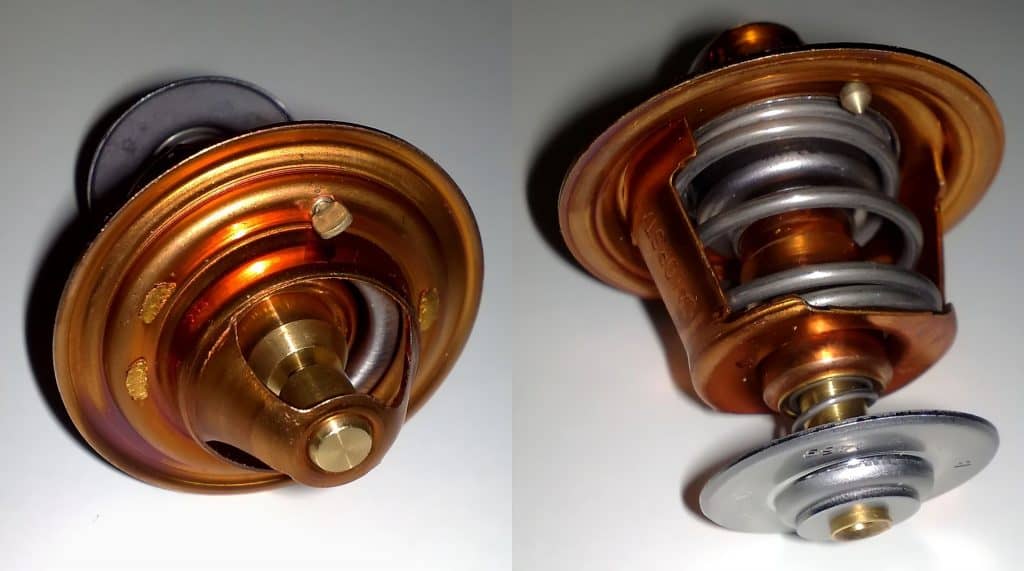
Therefore, check the thermostat and replace it if necessary each time you adjust the air conditioning or heating in your automobile.
Change your auto thermostat as soon as possible if your car is exhibiting indications of a faulty thermostat.
In many cases, a new thermostat is advised as preventative maintenance every time the cooling system is repaired, like during radiator hose replacement or a timing belt change.
How Much Time Does Car Thermostat Replacement Require?
Thermostat replacements may often be completed in an hour or less. Timing typically depends on how well you know your automobile if you need to replace any gaskets, and how sophisticated your car’s cooling system is.
Can I Change the Thermostat on My Car Myself to Save on Car Thermostat Replacement Cost?
A car thermostat replacement is not a difficult task, so if you are likely to attempt this task yourself, you might surely save money at the mechanic.
As you can see, purchasing a new thermostat is far less expensive than having a professional install it for you. This is a task that you could feel comfortable tackling by yourself if you’re comfortable with your home auto repairs.
You can often complete the task of replacing the thermostat in your automobile at home in less than an hour, and it is pretty straightforward. Possibly, you should first do a test to make sure the thermostat is indeed broken.
However, most car diagnostics are more expensive than the component itself, so you could decide against getting one.
Replacing the thermostat, on the other hand, can be a waste of money and time if other components of your car are malfunctioning as well as the thermostat.
Conclusion
Despite how straightforward it may seem, the thermostat is crucial to the general operation of your automobile. If a thermostat malfunctions, failing to fix it right away might result in very expensive repair fees down the road.
There is no justification for you to delay getting this fixed as soon as possible because of this. It’s one of those things you never want to put off for too long because there’s a chance for greater and much more expensive repairs down the road.
The car thermostat replacement cost is typically modest, and it can prevent expensive engine repairs or replacements down the line. The thermostat should be checked frequently because it is such an important component of your cooling system.
Although a thermostat should last the whole life of your car, unforeseen problems can always arise when driving any vehicle.
Make sure to get your automobile looked at as soon as possible if you experience any of the symptoms we listed to keep it operating smoothly and securely.
Use this guide to determine the appropriate replacement cost for your thermostat and when it needs to be replaced. Your thermostat should keep your engine in top condition and last the lifetime of your vehicle with a little care.
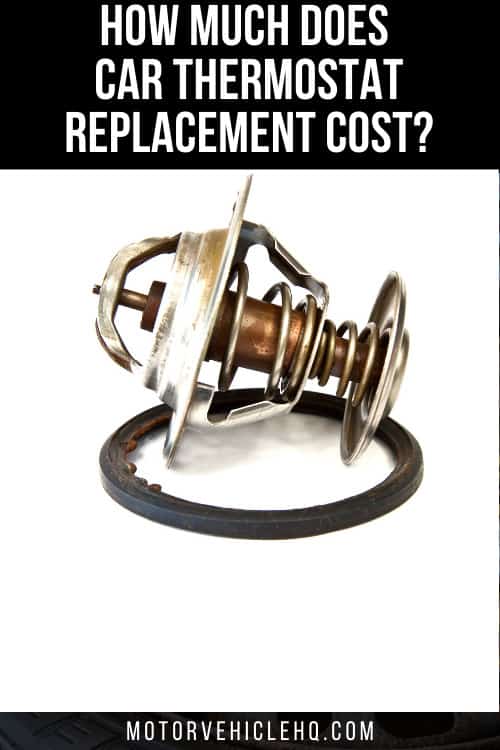

Jim Wicks is the founder of MotorVehicleHQ. With over two decades of experience in the automotive industry and a degree in Automotive Technology, Jim is a certified car expert who has worked in various roles ranging from a mechanic, car dealership manager, to a racing car driver. He has owned more than 20 cars over the past 15 years. Ask him about any vehicle you see on the road and he can tell you the make, model and year. He loves the aesthetics of all things cars, and keeps his vehicles in pristine condition.
In his free time, Jim enjoys getting his hands dirty under the hood of a classic car or taking long drives along the country roads. His favorite car? A 1967 Shelby GT500, a true classic that, according to Jim, “represents the pure essence of American muscle.”
